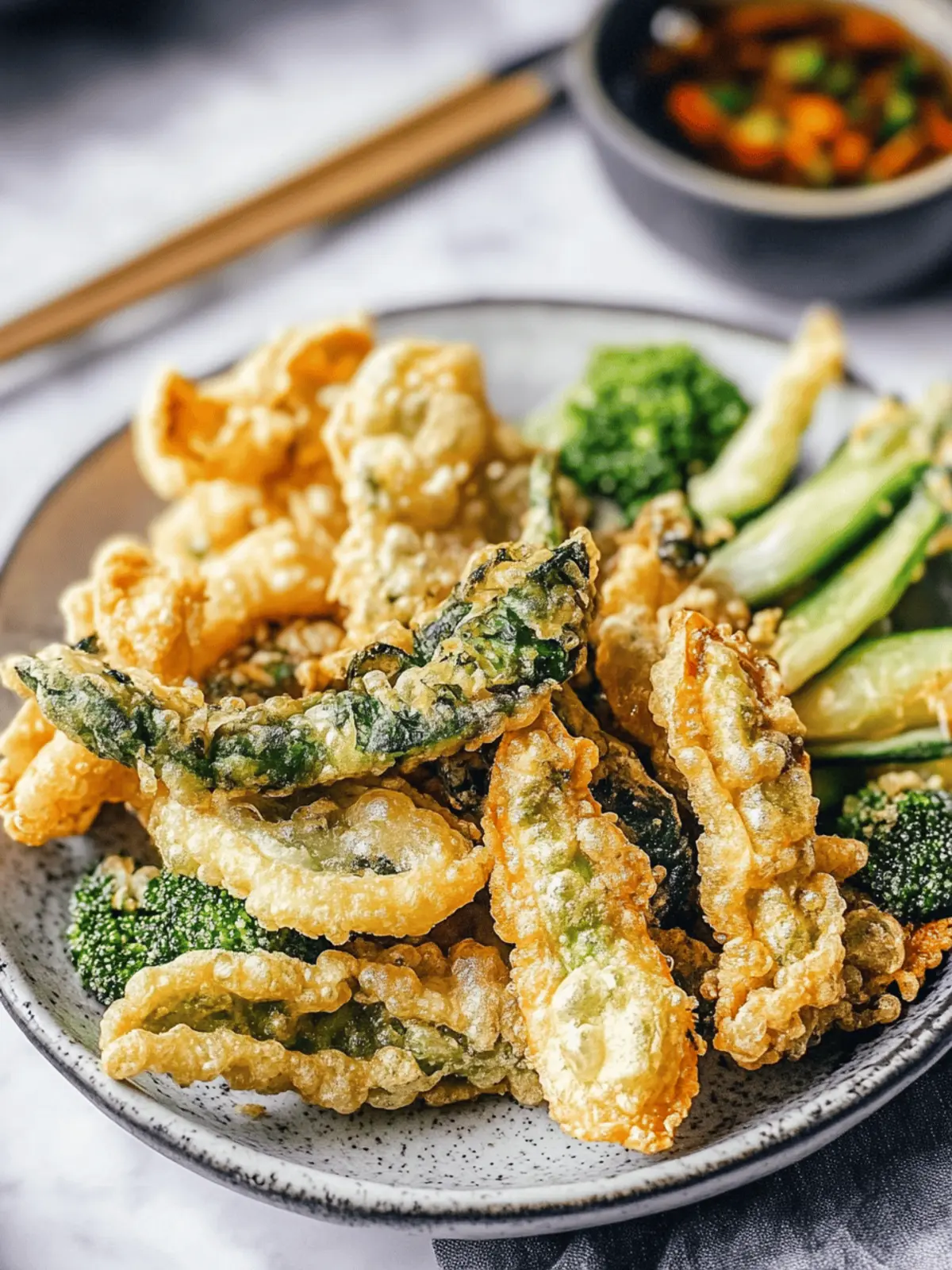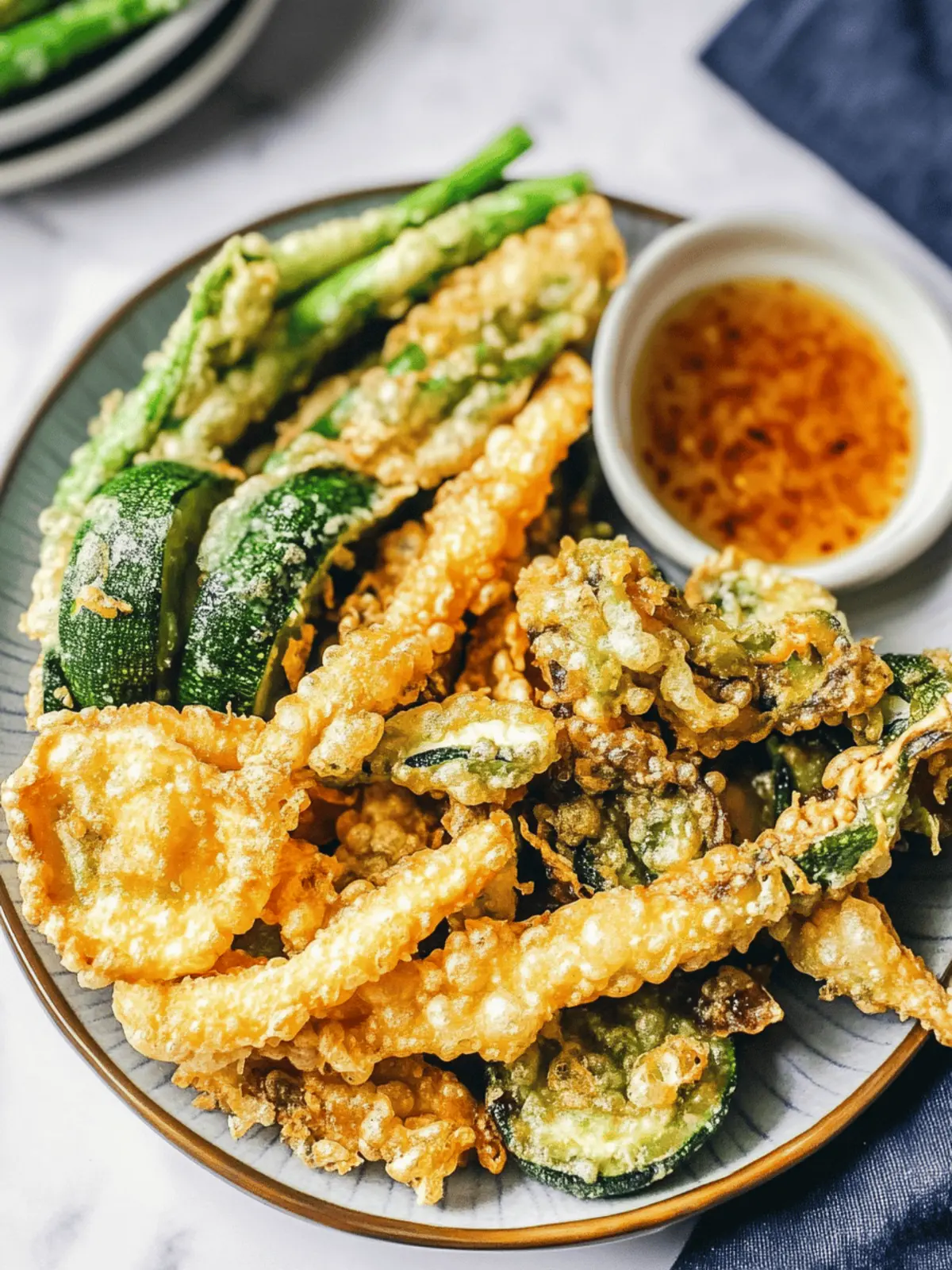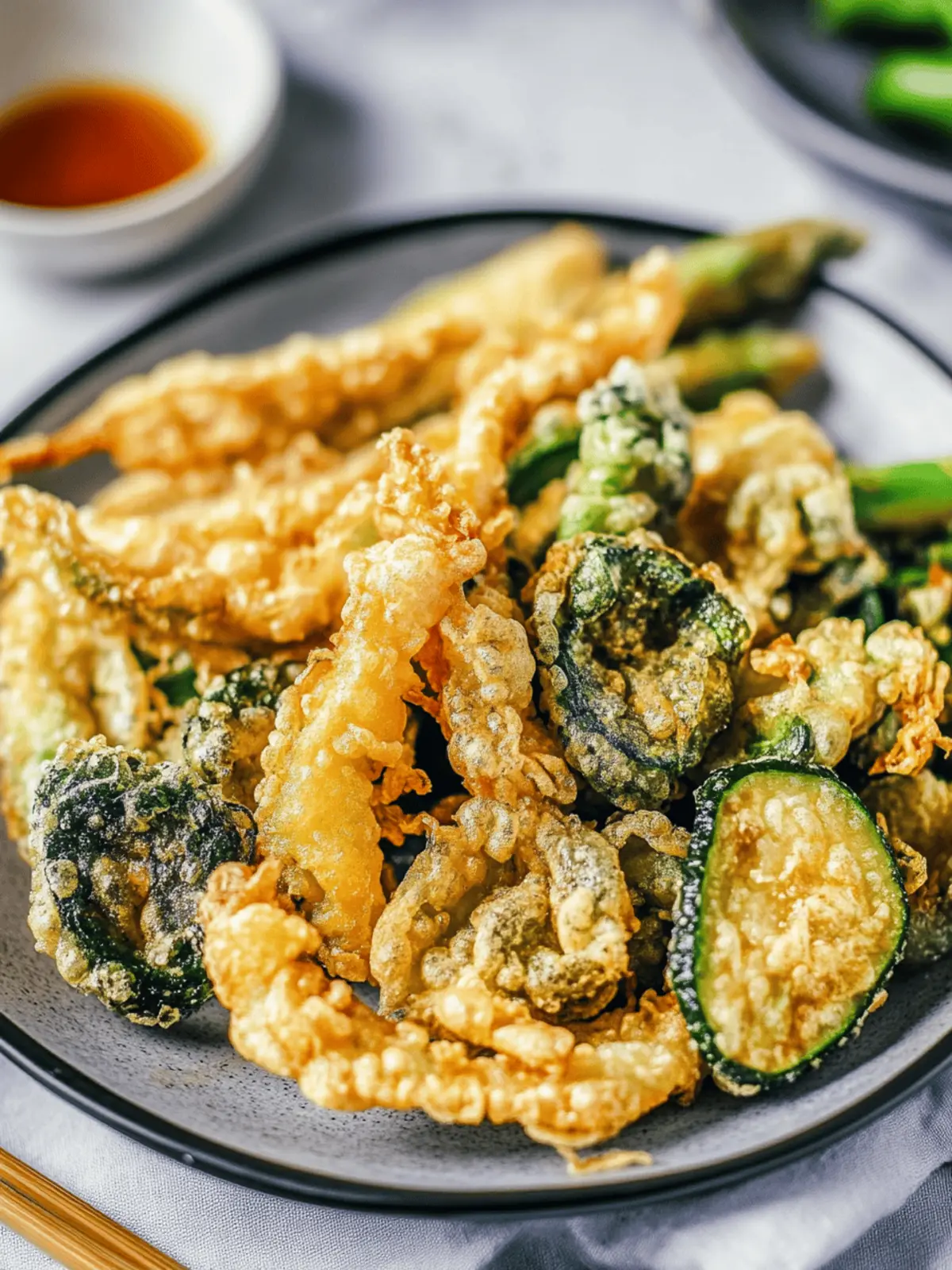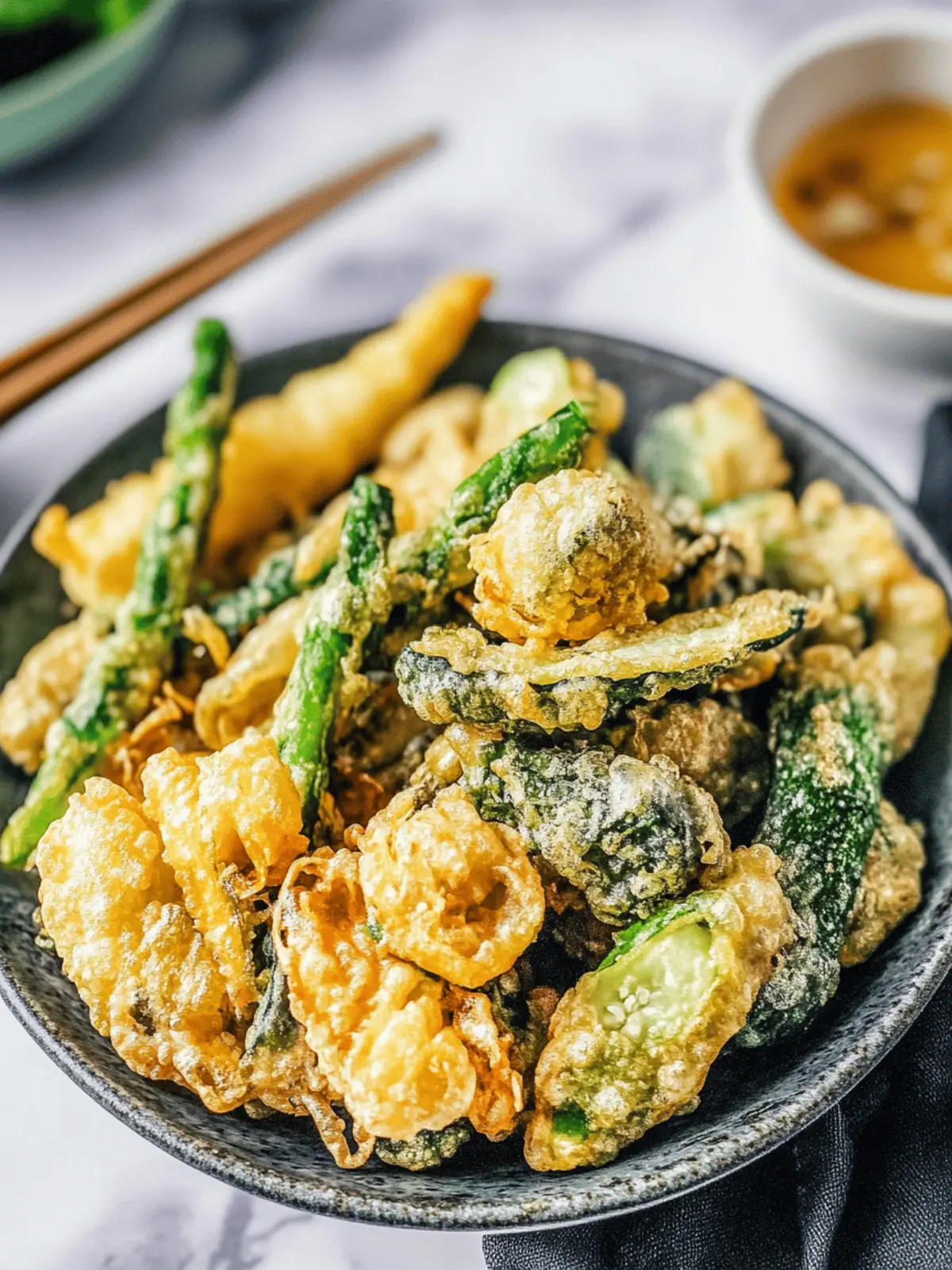When the sun sets and the cravings for something crisp and delicious kick in, I turn to my beloved vegetable tempura. The first bite bursts with the light crunch of perfectly battered vegetables—think golden slices of Korean sweet potato, hearty carrots, and delicate green onions. You wouldn’t believe that such a delightful dish could be whipped up in your own kitchen in under an hour!
This recipe, inspired by the street vendors of Korea, marries tradition and ease, making it ideal for anything from a casual family snack to an elegant appetizer at your next gathering. Plus, it’s versatile; whether you stick to the classic tempura batter or explore a gluten-free twist, you’re sure to impress. So, let’s channel those vibrant flavors and indulge in the art of crispy vegetable tempura, bringing a taste of street food right to our homes!
Why is Vegetable Tempura so Irresistible?
Crispy Texture: The light and airy batter creates an unforgettable crunch that makes each bite totally satisfying.
Quick to Make: In just under an hour, you can prepare this delicious snack, perfect for those last-minute cravings.
Versatile Ingredient Use: Feel free to swap in your favorite veggies, ensuring everyone at home finds something they love.
Crowd-Pleasing Snack: With its delightful flavors, it’s great for sharing at gatherings or family dinners.
Healthier Alternative: Using fresh vegetables gives it a nutritional boost, allowing for guilt-free indulgence.
Elevate Your Dishes: Pair with various sauces like soy or Yangnyeomjang to transform your meal into a culinary adventure!
Vegetable Tempura Ingredients
Here’s everything you need to create that crispy vegetable tempura at home!
For the Vegetables
• Large Yellow Onion – Adds a sweet, savory flavor; slice for even cooking.
• Korean Sweet Potato (Goguma) – Provides natural sweetness and a unique texture; can substitute with regular sweet potatoes.
• Carrots – Bring color and crunch; choose small to medium-sized for uniform cooking.
• Green Onion – Enhances flavor and freshness; cut to match the size of other veggies.
For the Batter
• Flour (All-Purpose) – The main structure ingredient for a classic batter; gluten-free flour can be used as a substitute.
• Cornstarch – Lightens the batter for that extra crispiness that makes your vegetable tempura a hit.
• Baking Powder – Helps create a light and airy texture in your batter.
• Egg – Binds the batter together; a flax egg works for a vegan-friendly option.
• Ice Cold Water – Ensures the batter stays cold for better crispiness; use 3 ice cubes for added fluffiness.
For Frying
• Vegetable or Canola Oil – Essential for deep frying; ensure there’s enough oil to allow the tempura to bubble without overflowing.
• Sea Salt – Optional, but enhances flavor tremendously; use to taste.
These carefully selected ingredients come together to create the delicious, crispy vegetable tempura that you’ll want to enjoy again and again!
How to Make Vegetable Tempura
-
Prep Vegetables: Begin by peeling and cutting the sweet potato and carrots into thin, french fry-sized sticks. Slice the onion and clean the green onions, combining all the prepared vegetables in a bowl for easy coating.
-
Prepare Oil: In a deep fryer or large pot, heat about 6 cups of vegetable or canola oil to 335-350°F (170-180°C). A thermometer can help ensure the oil reaches the perfect temperature for frying.
-
Mix Batter: In a medium bowl, combine the flour, cornstarch, sea salt, baking powder, egg, and ice cold water. Gently mix until just combined—remember, slight lumps are okay, so don’t overmix!
-
Coat Vegetables: Take the prepared vegetable sticks and dip them into the batter, ensuring they are evenly coated. This is where the magic happens, so ensure each piece gets a good layer!
-
Fry Tempura: Carefully add coated vegetable batches to the hot oil. Fry for 3-4 minutes, turning them as needed, until they are golden brown and irresistibly crispy.
-
Drain: Once cooked, transfer the tempura to a plate lined with paper towels to drain any excess oil, keeping them light and crisp.
-
Serve: Enjoy your vegetable tempura hot and fresh, paired with a dipping sauce such as a soy sauce and vinegar mix or the delightful Yangnyeomjang.
Optional: Garnish with sesame seeds or green onions for an extra pop of flavor.
Exact quantities are listed in the recipe card below.

What to Serve with Crispy Vegetable Tempura?
Creating a delightful meal revolves around pairing that enhances your dish, and vegetable tempura is the perfect star!
- Soy Sauce Dipping Sauce: A classic choice that adds umami and saltiness, balancing the tempura’s light crunch beautifully.
- Yangnyeomjang: This flavorful dipping sauce bursting with spices and sweetness elevates the tempura experience, creating an addictive snack.
- Fresh Vegetable Salad: Tossed with tangy dressing, a fresh salad provides a refreshing crunch, contrasting the fried elements perfectly.
- Steamed Jasmine Rice: Fluffy and fragrant, it serves as a lovely base, soaking up any sauces left on your plate while complementing the flavors.
- Korean Pickled Radishes: The tangy, crisp texture of these pickles offers a delightful contrast to the crispy batter, refreshing your palate with every bite.
- Chilled Sake or Soju: Pairing tempura with these traditional drinks can elevate your meal, making it feel special and authentic as you savor each bite.
Enjoy experimenting with these pairings, turning your crispy vegetable tempura into a memorable feast!
Vegetable Tempura Variations
Get creative with your vegetable tempura and explore different tastes and textures!
-
Gluten-Free: Swap all-purpose flour with a gluten-free flour blend for a crispy yet inclusive option.
-
Vegan Alternative: Replace the egg with a flax egg (1 tbsp ground flaxseed + 2.5 tbsp water) to keep things plant-based but delicious.
-
Sweet Potato Swap: Use regular sweet potatoes instead of Korean sweet potatoes for a different flavor while maintaining sweetness.
-
Go Spicy: Add a pinch of cayenne pepper or chili flakes to the batter for a kick that contrasts beautifully with the crispy veggies.
-
Add More Crunch: Incorporate crushed rice cereal into the batter for an extra layer of texture—perfect for those who adore maximum crispiness.
-
Seafood Delight: Mix in shrimp or squid with the vegetables for a more adventurous seafood tempura experience.
-
Vegetable Variety: Experiment with seasonal veggies like zucchini, bell peppers, or asparagus to bring new flavors to your tempura.
-
Herb Infusion: Add finely chopped herbs like cilantro or dill to the batter for a refreshing twist that pairs wonderfully with the fried treats.
Every bite can take you on a unique journey—happy cooking!
Make Ahead Options
These Vegetable Tempura are perfect for home cooks looking to save time during busy weeknights! You can prep the vegetables by slicing the Korean sweet potato, carrots, and onions up to 24 hours in advance. Store the cut veggies in an airtight container with a damp paper towel to maintain freshness. You can also prepare the batter and refrigerate it for up to 3 days. Just remember to keep it covered and stir gently before using to maintain that airy texture. When it’s time to enjoy your tempura, simply heat the oil, dip the prepped vegetables in the batter, and fry them for a delightful snack that’s just as crispy and delicious as if you made them fresh!
Expert Tips for Vegetable Tempura
- Oil Temperature: Ensure the oil is heated to 335-350°F (170-180°C). Too hot can burn the batter, while too cold results in soggy tempura.
- Don’t Overcrowd: Fry in small batches to keep the oil temperature stable and ensure even cooking of the vegetable tempura.
- Batter Consistency: Mix just until combined—overmixing can lead to dense batter instead of the light, crispy texture we desire.
- Keep It Cold: For the crispiest finish, keep the batter cold by adding ice cubes to the water before mixing.
- Vegetable Preparation: Cut your vegetables into uniform sizes for even cooking; thinner pieces will cook more quickly and yield a better crunch.
- Flavorful Dips: Serve tempura with a variety of dipping sauces like soy or Yangnyeomjang to enhance its delightful flavor.
How to Store and Freeze Vegetable Tempura
Room Temperature: Enjoy your vegetable tempura fresh and hot for the best taste. If left out, it can sit for about 2 hours before it should be refrigerated.
Fridge: Store leftover vegetable tempura in an airtight container for up to 3 days. Reheating is best done in the oven to maintain that beloved crispiness.
Freezer: For longer storage, freeze cooked vegetable tempura in a single layer on a baking sheet, then transfer to a freezer bag. It can remain fresh for up to 3 months.
Reheating: When ready to enjoy, reheat the frozen vegetable tempura in a preheated oven at 375°F (190°C) for about 15-20 minutes until heated through and crispy again.

Vegetable Tempura Recipe FAQs
What vegetables are best for making vegetable tempura?
Absolutely! You can use a variety of fresh vegetables for tempura. The classics include Korean sweet potatoes, carrots, and onions, but feel free to experiment with zucchini, bell peppers, or even lotus roots for different textures and flavors!
How should I store leftover vegetable tempura?
Store any leftover vegetable tempura in an airtight container in the refrigerator for up to 3 days. To retain its delightful crispiness, I recommend reheating it in an oven at 375°F (190°C) for about 10-15 minutes instead of using a microwave.
Can I freeze vegetable tempura?
Yes, you can freeze your cooked vegetable tempura! To do this, place the tempura on a baking sheet in a single layer and freeze until solid, typically about 1-2 hours. Once frozen, transfer them to a freezer bag or airtight container. It can be stored for up to 3 months. When ready to eat, reheat directly from the freezer in a preheated oven at 375°F (190°C) for about 15-20 minutes until crispy.
What should I do if my tempura batter turns out too thick?
If your batter is too thick, simply stir in a bit more ice-cold water, one tablespoon at a time, until you reach the desired consistency. Remember, a light and airy batter is key to achieving that perfect crispiness!
Are there any allergen considerations for vegetable tempura?
Definitely. If you’re serving guests with dietary restrictions, you can easily make the batter gluten-free by substituting all-purpose flour with a gluten-free flour blend. For those who are vegan, you can replace the egg with a flax egg (mix 1 tablespoon of ground flaxseed with 2.5 tablespoons of water and let it sit for 5 minutes). Always check ingredient labels for allergens!
How do I know when the oil is ready for frying?
You can use a thermometer to ensure the oil reaches 335-350°F (170-180°C). If you don’t have one on hand, drop a small amount of the batter into the oil; if it sizzles and rises to the surface, it’s ready for frying!

Crispy Vegetable Tempura: Your New Favorite Snack Adventure
Ingredients
Equipment
Method
- Begin by peeling and cutting the sweet potato and carrots into thin, french fry-sized sticks. Slice the onion and clean the green onions, combining all the prepared vegetables in a bowl for easy coating.
- In a deep fryer or large pot, heat about 6 cups of vegetable or canola oil to 335-350°F (170-180°C). A thermometer can help ensure the oil reaches the perfect temperature for frying.
- In a medium bowl, combine the flour, cornstarch, sea salt, baking powder, egg, and ice cold water. Gently mix until just combined—remember, slight lumps are okay, so don't overmix!
- Take the prepared vegetable sticks and dip them into the batter, ensuring they are evenly coated.
- Carefully add coated vegetable batches to the hot oil. Fry for 3-4 minutes, turning them as needed, until they are golden brown and irresistibly crispy.
- Once cooked, transfer the tempura to a plate lined with paper towels to drain any excess oil.
- Enjoy your vegetable tempura hot and fresh, paired with a dipping sauce such as a soy sauce and vinegar mix or the delightful Yangnyeomjang.






